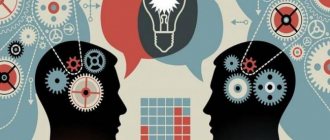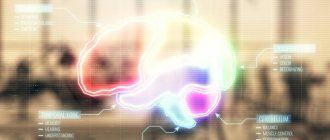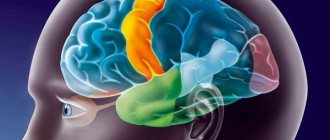Author's rating
Author of the article
Smirnova Olga Leonidovna
Neurologist, education: First Moscow State Medical University named after I.M. Sechenov. Work experience 20 years.
Articles written
94
A person constantly creates a model of the world in his consciousness, during which the brain is active and takes forms called visual-effective or figurative thinking. Science gives its own explanation for this: this is the main type of human thought processes since the times of primitive society, the peculiarity of which is that it is associated with solving practical problems. Thanks to this type of thinking, a person realizes the need to perform some action, for example, buy groceries or do exercises.
Everyone develops their own picture (or model) of the world. Thanks to the activity of brain cells, a person gains knowledge about the world around him and his existence. He carries out practical activities to change reality, using visual and effective thinking.
A person’s thinking ability, as it develops, goes through three stages, on which the type of thinking depends:
- Visually effective.
- Visual-figurative.
- Verbal-logical.
Effective helps to solve necessary tasks with the help of hands (touching an object): take, move, build, pour out, break, etc. It is especially important for infants and older children (1-3 years) to improve fine motor skills of their fingers. This has a connection with the formation of consciousness. Therefore, the first stage in development is to launch visual and effective thinking.
This type is considered the main one and is actively used by children. These are movements without the participation of speech; they are performed with the help of actions in relation to objects that are currently in the baby’s field of vision.
The type of thinking in different sources has the following definitions: elementary, basic, simplest, lowest. Its signs are noticeable even in animals.
The peculiarity is the close connection of thought processes with the actions performed. A child, repeatedly playing with the same object, gradually reveals its internal characteristics and features. A little person develops skills by acting “by example.” Thus, an object in the hands of a baby is a way of understanding the world around him.
What is thinking
Thinking is a cognitive process that allows a person to perceive, realize reality and express this in his own activities. It endows surrounding objects with properties and relationships with each other. Thanks to mental activity, each person’s picture of the world is formed.
There are the following main signs of thinking:
- Mediation – cognitive activity is based on data from the senses and does not interact directly with reality;
- Generalization is the ability to find common properties in objects of the same type.
These characteristics are inherent in every person. In mental illness, a disorder in the basic features of thought processes may occur - for example, the search for similarities in dissimilar objects.
Right-brain and left-brain thinking
Each hemisphere is characterized by the predominance of certain processes. Based on this feature, the main types of thinking were identified:
- Left hemisphere - the process is dominated by analytical and synthetic processes, logical constructions;
- Right-hemisphere - relies on images and intuition;
- Mixed is the alternate work of each hemisphere;
- Integrated – simultaneous work of both hemispheres.
It is wrong to say that one type of mental activity is preferable to another. Each of them is capable of coming to both correct and incorrect conclusions. Left-hemisphere thinking gives leadership qualities, right-hemisphere thinking gives a strong emotional response. Mixed, thanks to its ability to “switch,” can use the strengths of both hemispheres. But this process does not always happen on time. The same goes for the integrated type.
Classification
In psychology, types of thinking are distinguished depending on the way a person comes to conclusions:
- Visual-effective - cognitive activity based on the perception of specific objects and manipulations with them;
- Visual-figurative – relies on images and judgments, allows the use of specific images to illustrate conclusions;
- Verbal-logical – based on logical constructions and inferences. Able to reason about abstract concepts;
- Subject-effective – close to visual-effective. Used to solve applied problems;
- Empirical - using lived experience to make inferences.
Each person has all types to one degree or another. The verbal-logical or abstract type develops later than the others. Characteristic only for humans. Other types appear to varying degrees in some animals. In essence, abstract thinking allows a person to use a wide conceptual apparatus and transfer knowledge through indirect sources - a book, an educational film, etc.
Visually effective type
This is the earliest form of mental activity that develops in humans. It is typical for children under 3 years of age. Mental operations are based on manipulations with really existing tangible objects. Each problem is solved immediately at the practical stage, during manipulations with objects. Thinking disorders of this type are rare. Mainly with severe mental retardation. They lead to the fact that the process of development of brain activity as a whole slows down or stops.
How and when does developmental disorder develop?
This is the first stage in the development of mental activity. The time frame for its development to begin varies. Some experts indicate that a child is capable of simple mental operations from birth. Others say that the development of mental processes is closely related to the ability to move and appears simultaneously with a decrease in muscle hypertonicity. Estimated time frame: 6 months – 1 year.
Vivid and uncontrolled manifestations of visual-effective thinking in children over 3 years of age, adolescents and adults indicate serious mental disorders - mental retardation, regression in psychosis. The patient exhibits a pronounced desire to grab, break and hide surrounding objects.
Manual or visual-effective thinking of children and ways of its development
This type of solving life problems got its name due to the fact that the child constantly performs some kind of manipulation with surrounding objects. The most striking manifestations are the baby grabbing toys, knocking them, testing them, licking them, trying to take them apart and put them back together.
It makes no sense to wean a child from these manipulations; a much more important task for parents is to provide the child with toys that he can disassemble and assemble without damaging them. An excellent option is sorters. This educational toy has many functions and modifications. The principle of operation is usually similar - assemble, disassemble, correlate colors, edges, shapes. This is both a puzzle and a construction set in one toy. Check out the selection of smart toys in different prices and variations.
Visually effective type of thinking in adults
In adults, such mental operations are involved in cases where the result of actions cannot be predicted on the basis of existing inferences. A striking example is mastering an unfamiliar technique. Arrangement of furniture in the room or objects on the table, selection of necessary materials according to shape, texture, subjective sensations.
Thinking: forms, properties, types, methods of development in children
Anastasia Kondratieva
Thinking: forms, properties, types, methods of development in children
Thinking is the process of indirect and generalized cognition (reflection) of the surrounding world. Its essence lies in the reflection of: 1) general and essential properties of objects and phenomena, including properties that are not directly perceived; 2) significant relationships and natural connections between objects and phenomena.
Basic forms of thinking
There are three main forms of thinking: concept, judgment and inference.
A concept is a form of thinking that reflects the general and, moreover, essential properties of objects and phenomena.
Every object, every phenomenon has many different properties and characteristics. These properties, signs, can be divided into two categories - essential and non-essential.
Judgments reflect connections and relationships between objects and phenomena of the surrounding world and their properties and characteristics. Judgment is a form of thinking that contains the affirmation or denial of any position regarding objects, phenomena or their properties.
Inference is a form of thinking in which a person, comparing and analyzing various judgments, derives a new judgment from them. A typical example of inference is the proof of geometric theorems.
Properties of thinking
The main properties of human thinking are its abstraction and generalization. Abstract thinking consists in the fact that, thinking about any objects and phenomena, establishing connections between them, we single out only those properties and signs that are important for solving the issue facing us, abstracting from all other signs, in this case us not interested: while listening to the teacher’s explanation in class, the student tries to understand the content of the explanation, highlight the main ideas, and connect them with each other and with his past knowledge. At the same time, he is distracted from the sound of the teacher’s voice and the style of his speech.
Abstract thinking is also closely related to its generality. By highlighting the most important aspects, connections and relationships that are significant from one point of view or another, we thereby focus our thoughts on that common thing that characterizes entire groups of objects and phenomena. Each object, each event, phenomenon, taken as a whole, is unique, as it has many different aspects and characteristics.
Types of thinking
In psychology, the following simplest and somewhat conventional classification of types of thinking is common: 1) visual-effective, 2) visual-figurative and 3) abstract (theoretical) thinking. Thinking is also distinguished between intuitive and analytical, theoretical, empirical, autistic and mythological.
Visual-effective thinking.
In the course of historical development, people solved the problems facing them first in terms of practical activity, only then did theoretical activity emerge from it. Practical and theoretical activities are inextricably interconnected.
Only as practical activity develops does it emerge as a relatively independent theoretical mental activity.
Not only in the historical development of mankind, but also in the process of mental development of each child, the starting point will be not purely theoretical, but practical activity. It is within this latter that children's thinking first develops. In pre-preschool age (up to three years inclusive), thinking is mainly visual and effective. The child analyzes and synthesizes cognizable objects as he, with his hands, practically separates, dismembers and reunites, correlates, connects with each other certain objects perceived at the moment. Curious children often break their toys precisely in order to find out “what’s inside.”
Visual-figurative thinking.
In its simplest form, visual-figurative thinking occurs primarily in preschool children, i.e., at the age of four to seven years. Although the connection between thinking and practical actions is preserved, it is not as close, direct and immediate as before. During the analysis and synthesis of a cognizable object, a child does not necessarily and does not always have to touch the object that interests him with his hands. In many cases, systematic practical manipulation (action) with an object is not required, but in all cases it is necessary to clearly perceive and visually represent this object. In other words, preschoolers think only in visual images and do not yet master concepts (in the strict sense).
Abstract thinking.
On the basis of practical and visual-sensory experience, children of school age develop, first in the simplest forms, abstract thinking, that is, thinking in the form of abstract concepts.
Mastering concepts as schoolchildren learn the fundamentals of various sciences - mathematics, physics, history - is of great importance in the mental development of children. The formation and assimilation of mathematical, geographical, physical, biological and many other concepts during school education are the subject of numerous studies. The development of abstract thinking in schoolchildren during the assimilation of concepts does not at all mean that their visual-effective and visual-figurative thinking now ceases to develop or disappears altogether. On the contrary, these primary and original forms of all mental activity continue to change and improve, developing together with abstract thinking and under its influence.
Intuitive and analytical thinking.
Analytical thinking is characterized by the fact that its individual stages are clearly expressed and the thinker can tell another person about them. An analytically thinking person is fully aware of both the content of his thoughts and the operations that comprise them. Analytical thinking in its extreme form takes the form of careful deductive inference.
Intuitive thinking is characterized by the fact that it lacks clearly defined stages. It is usually based on a compressed perception of the entire problem at once. The person in this case arrives at an answer, which may be right or wrong, with little or no awareness of the process by which he arrived at that answer. Therefore, the conclusions of intuitive thinking need to be verified by analytical means.
Intuitive and analytical thinking complement each other. Through intuitive thinking, a person can often solve problems that he would not have solved at all or, at best, would have solved more slowly through analytical thinking.
Theoretical thinking.
Theoretical thinking is thinking that does not lead directly to practical action. Theoretical thinking is contrasted with practical thinking, the conclusion of which is, as Aristotle puts it, action. Theoretical thinking is guided by a special attitude and is always associated with the creation of a specific “theoretical world” and drawing a fairly clear boundary between it and the real world.
Empirical thinking.
We can distinguish at least three vital functions of empirical thinking.
Firstly, empirical thinking provides a person with an awareness of similarities and differences. The most important task of thinking when faced with an infinite variety of sensory-given properties and relationships of things is to separate them, to focus on what is similar and different, and to highlight a general idea of objects.
Secondly, empirical thinking allows the subject to determine the measure of similarity and difference. Depending on practical and everyday tasks, a person can define the same objects, phenomena, situations as more or less similar and different.
Thirdly, empirical thinking makes it possible to group objects according to generic relations and classify them.
Ways to develop thinking
Development of visually effective thinking in children.
By the age of 5-6 years, children learn to perform actions in their minds. The objects of manipulation are no longer real objects, but their images. Most often, children present a visual, visual image of an object. Therefore, a child’s thinking is called visual-effective.
To develop visual and effective thinking, the following techniques should be used when working with children:
1) Learning to analyze a visual image (an adult can draw the child’s attention to individual elements of objects, ask questions about similarities and differences).
2) Learn to identify the properties of objects (children do not immediately understand that different objects can have similar properties; for example: “Name 2 objects that have three characteristics at once: white, soft, edible”).
3) Learning to recognize an object by a description of possible actions with it (for example, riddles).
4) Learning to find alternative methods of action (for example, “What to do if you need to know the weather outside?”).
5) Learning to compose narrative stories.
6) Learning to make logical conclusions (for example, “Petya is older than Masha, and Masha is older than Kolya. Who is the oldest?”).
Development of logical thinking in children.
To develop logical thinking in preschool children, the following techniques are used:
1) Teaching the child to compare objects (for example, “Find 10 differences in the following pictures”).
2) Teaching a child to classify objects (for example, the game “What’s extra?”).
3) Teaching a child to search for identical properties or signs of objects (for example, among toys, invite the child to find 2 identical ones).
Development of logical thinking in children of primary school age:
1) Use of exercises aimed at developing the ability to divide objects into classes (for example, “Read the words (lemon, orange, plum, apple, strawberry) and name the berries and fruits”).
2) Formation of the ability to define concepts.
3) Formation of the ability to identify essential features of objects.
Thinking acts mainly as a solution to tasks, questions, problems that are constantly put forward to people by life. Solving problems should always give a person something new, new knowledge. Finding solutions can sometimes be very difficult, so mental activity, as a rule, is an active activity that requires concentrated attention and patience. The real process of thought is always a cognitive process.
Bibliography:
1. Brief psychological dictionary / ed. A. V. Petrovsky, M. G. Yaroshevsky. – Rostov-ND, 1998.
2. Gippenreiter Yu. B. Introduction to general psychology: Textbook / Yu. B. Gippenreiter. - M.: Omega L, 2006.
3. Tertel A. L. Psychology. Course of lectures: Textbook / A. L. Tertel. – M.: Prospekt, 2006.
4. Diagnosis and correction of mental development of preschool children: Textbook/Ed. Y. L. Kolominsky, E. A. Panko. – Mn., 1997.
5. Uruntaeva G. A. Workshop on child psychology: Textbook / G. A. Uruntaeva, Yu. A. Afonkina. – M.: Education, 1995.
Visual-figurative type
This form of thinking manifests itself in the fact that the child is able to imagine the final result of his actions. With the visually effective method, the baby has no idea about the result of his actions, but remembers the relationships as a result of repetition. With visual-figurative learning, the preschooler guesses what the result will be.
How and when it develops, what developmental disorders exist
Visual-figurative thinking is formed on the basis of visual-effective thinking. Formation begins at the age of about 3 years. This is the main type of mental activity of preschoolers. Reaches a peak at 5-6 years.
Signs that the baby has the beginnings of imaginative thinking:
- he is able to recognize objects without touching them,
- is able to select several similar objects,
- break simple tasks into several interconnected components.
Tools for developing an imaginative way of thinking - prefabricated toys (pyramids, cubes, puzzles -), then - observing nature, retelling what you heard, drawing from memory. The criterion that imaginative thinking is actively developing is that the baby can describe his actions before starting them.
Visual-figurative thinking disorders in childhood are a lack of skills characteristic of this stage, loss of interest in complex toys. In adults, such disorders look like this:
- Aimless manipulation of objects. Example – a patient may strike a lighter for a long time and aimlessly;
- Ridiculous actions with objects that create the feeling of a child's game;
- Imitative actions;
- Mimo actions - similar to correct ones, but deliberately ineffective (lighting a match with the other end);
- Destructive actions - aggressive or auto-aggressive.
This behavior is typical for patients with psychosis, catatonic disorders, and schizophrenia.
How do images help in mental activity?
An image is a holistic idea of the result of one’s activities. It becomes the basis for the formation of more complex abstract thinking and supports the ability to perceive holistically. In adults, the main function of images is setting goals for their actions, emotional involvement in activities, and the formation of a creative approach.
Important
Imaginative thinking can only work with those phenomena that it has already encountered, so observation is extremely important at this stage of development. Emotions are always included in the perception of an image - this is important for both children and adults engaged in creative work. At the same time, this type of brain work is not characterized by special attention to detail - it notices the important and essential qualities of an object, while the rest can be distorted or discarded.
How visually effective thinking develops in preschoolers
Supporting the development of visually effective and imaginative thinking in preschoolers is simple: the key goal of parents is not to interfere with the dismantling or “modernization” of objects. The only limitation is security measures. Materials should be as harmless as possible for younger preschoolers.
Object actions do not immediately lead the child to understand the main features and purpose of the object. It takes time and repeated manipulations for the child’s mind to grasp visual generalizations and build the necessary connections.
For example, if a preschooler made his first attempts to draw with a pencil, then when he sees colored crayons he will not imagine their purpose without preliminary tests.
It is especially effective to form the memory of images with the help of flowing and bulk materials. The child pours sand from hand to hand, makes slides from cereals, and pours water. Constant touching allows him to first determine and then remember that if the sand is properly crushed, it will turn out to be a Easter cake.
To summarize what has been said, the basic principle of the development of this form of thought process is expressed in repeated actions leading to the same result: a picture, an assembled toy, a sculpted figurine.
This is how the first ideas about specific objects and life experience arise, which lay the foundation for the development of mental forms.
Abstract boolean type
Abstract thinking operates not only with images, but also with abstract concepts. A person who has developed this type of mental activity is able to systematize information and purposefully search for it, and plan his activities. It is considered the highest degree of development of brain activity, characteristic only of humans.
How and when it develops, possible developmental disorders
The formation of abstract thinking begins at 5-7 years of age. Late preschool and early school period. The full ability to operate with abstract concepts is formed in adolescents and remains throughout life.
Signs that a preschooler has begun to develop logical thinking:
- meaningful use of abstract concepts in speech,
- the emergence of the skill of detailed planning of one’s activities,
- understanding cause-and-effect relationships in the actions of others.
All these operations occur without direct contact with objects.
Impaired brain activity manifests itself in the inability to generalize, highlight the main thing, and understand the figurative meaning of words and expressions. To identify such disorders, tests are used in which you need to interpret a proverb or saying and identify fundamental similarities between different objects.
Peculiarities
This type of thinking uses complex logical operations. In adolescents and adults it is the main one. Thanks to it, a person is able to plan, set goals and evaluate their feasibility, evaluate his own actions and the actions of others, draw conclusions and learn from his own and others’ experiences. Characterized by deep attention to detail, understanding of context, low emotional involvement.
Specific subject type
A selection of construction kits that perfectly develop subject-specific thinking
Like visual-effective thinking, the concrete-object type is associated with direct interaction with objects, but is its more developed type. A person with concrete-subject thinking, unlike a small child, has a goal and imagines the result of his actions. This type of mental activity accompanies applied operations, most often in the technical field. It allows you to “adjust” certain devices to a specific situation.
How and when does developmental disorder develop?
Practical thinking begins to develop around 4-7 years, the start time is quite flexible. What is needed is a developed visual-figurative method and the presence of at least the rudiments of the abstract-logical. This type of mental activity is formed on the basis of constant work with hands, requiring a creative approach. He is well developed by construction sets and other complex toys - a good selection.
Developmental disorders manifest themselves in the form of an inability to follow instructions, difficulty in moving from theory to practice.
What is this in psychology?
The first stage of mental development is visual and effective thinking (from 0 to 3 years). This form of thinking is characterized by the relationship between the physical properties of an object and the possibilities of its use; it is also called “manual intelligence”.
Which hemisphere is responsible for it?
Important. The human brain is a complex system responsible for all body processes.
In the 1990s, V. Rotenberg hypothesized that the left hemisphere is responsible for logical thinking. It is narrowly focused, as it connects the object with the problem being solved. While the right one covers more expanded possibilities, correlating information from different sources, forming images. Both hemispheres work in conjunction.
Forms (criteria) of thinking
Thinking operates with several basic categories, which are characteristic mainly of the abstract-logical type.
- A concept is the simplest act of mental activity. It reflects the very fact of understanding objects or phenomena. The external manifestation of the concept is the ability to name an object using its main features (black cat, cold rain, bad mood, etc.).
- Judgment is the ability to establish relationships between concepts and combine them into groups. External expression is the ability to describe one concept using others in a sentence. Examples of judgments: a cat and a dog are animals; rain is precipitation in the form of water.
- Inference - allows you to derive new judgments from existing ones that are interconnected. An example of a conclusion: rain is precipitation in the form of water, in winter the water freezes, which means rain is possible only in summer. Inferences can be true or false. An example of an incorrect inference is that a cat is an animal, the cat meows, which means all animals meow.
A separate type of inference is a hypothesis. It is based partly or entirely on assumptions and requires verification and evidence. In everyday life, a person makes several hundred inferences a day. For example, from the readings of the thermometer outside the window, he makes a conclusion about what clothes to wear.
Operations of thinking
- Operations are unique units of measurement for thinking. At their expense, mental activity is carried out. They are present at any stage of development of intellectual abilities, but manifest themselves in different forms.
- Comparison is the search for differences and similarities between objects. Based on comparison, objects can be grouped based on similarity.
- Analysis is the division of an object into its components. At the simplest stage, it is accompanied by physical separation of the object (the child breaks toys).
- Synthesis is an operation opposite to analysis - recreating the appearance of a whole object from its parts.
- Abstraction is the selection of essential features of an object, ignoring non-essential ones.
- Concretization is an operation opposite to abstraction - identifying the specific characteristics of an object, perceiving its diversity.
- Induction is the derivation of conclusions from the particular to the general, the distribution of knowledge about a specific object to the entire group of similar objects.
- Deduction is an operation opposite to induction - drawing conclusions from the general to the particular, distributing knowledge about a group of objects to each object of this group.
Read more in the article Deductive Reasoning
- Classification is the division of objects according to their differences. Performed on a comparison basis.
- Generalization - identifying common features for different objects. This operation is performed on a comparison basis.
Why is it important to develop creative thinking?
The very concept of “image” means the imprinting of objects and phenomena of the real world in human consciousness, the formation of an imaginary appearance.
A preschooler, especially an older one, is already able to accumulate a sufficient number of such reflections. Moreover, sometimes they are not visual, but tactile or audio in nature.
The skill of imaginative thinking greatly simplifies a child’s interaction with the outside world. To solve a given problem, he just needs to imagine all its components and find the answer.
In the future, properly developed imaginative thinking will make it easier to master spatial thinking and imagine the world in three-dimensional display.
It is especially important to pay attention to the child at the stage of development of imaginative thinking for the following reasons:
- The ability to operate with images significantly speeds up the solution of first everyday, and later logical and mathematical problems.
- The ability to think in images forms the aesthetic component of the personality and the craving for beauty, which intensifies as one grows older.
- Operating with images contributes to the development of creative thinking.
Types of thinking
Types of thinking are features associated with which of the operations predominates during the formation of inferences. This does not mean that the others are not fulfilled. The brain cannot limit itself to one type of operation, otherwise all conclusions will be incorrect.
Deductive
It is based on initial statements that are valid for most cases (axioms, less often hypotheses). From them, through a chain of logical conclusions, a conclusion is drawn that is fair in a certain situation. An important condition is that the original statement must be true.
Critical
This type of thinking is based on knowledge, information analysis and individual personality traits. In psychiatry, critical thinking refers to the ability to evaluate the appropriateness of one's behavior.
Inductive
This is the ability to form conclusions based on private knowledge and personal experience, to draw conclusions that should be valid for the entire group of objects. Judgments will be correct if the feature that unites objects into a group is chosen correctly.
Analytical
Based on the operation of analysis, it is highly structured, orderly, and has a deep understanding of the essence of processes. Weakness: low ability to organize activities.
Investigative
A combination of analysis and setting new tasks. Allows you to study objects in more detail, identify relationships and formulate tasks for the future.
You may also be interested in reading Profiling. 10 rules and 20 tricks to read people like a book
Systematic
Based on identifying the relationships between objects and their deep understanding. Perception of the surrounding world in interaction.
Creative
The main feature is flexibility, the search for new goals or new ways to achieve known goals.
Synthetic
It's about putting together different "pieces of the puzzle." Allows you to plan tasks, set important goals, and highlight the most significant details.
Interrogative
This type combines all operations equally. The main way of knowledge is to ask questions, find answers to them, from which new questions follow.
Divergent
This type of thinking finds a number of alternatives for any action, from which it consistently chooses the optimal path.
Types of thinking disorders
In psychopathology, the following types of thinking disorders are distinguished:
- Violation of the dynamics of thinking.
- Violation of the operational side of thinking.
- Violation of the motivational component of thinking.
- Impaired critical thinking.
Disturbances in the dynamics of thinking
These include inertia of thinking and its lability.
Inertia is expressed in difficulty when switching from one way of doing work to another. Generalizing the material when conditions change can be difficult; viscosity of thinking, excessive thoroughness, excessive detail, and slowness of thought processes may appear.
Lability is the instability, mobility of the way of performing a given task. In this case, adequate and inadequate solutions alternate. With a good level of generalization in general, from time to time there is a “glitch” due to random, incorrect combinations. New impressions change the course of thoughts, the logic of reasoning is disrupted, associations are chaotic, ideas “jump”, a person talks incessantly - these are the manifestations of this type of thinking disorder. The following options are available:
- generalized situations alternate with specific situational ones;
- logical connections are mistakenly replaced by random combinations;
- groups of the same name are formed.
Violations of the operational side of thinking
These include a decrease in the level of generalization and distortion of the generalization process.
A decrease in the level of generalization is characterized by a predominance in judgments of direct, specific connections between objects and phenomena. So, for example, when classifying objects into one group, heterogeneous concepts are combined (for example, a pen and a table, because it is convenient to write with a pen at the table), that is, objects are combined on the basis of private or secondary characteristics.
Distortion of the generalization process is the opposite process, in which there is a departure from specific connections, and in an exaggerated form. In this case, generalization is carried out on the basis of either insignificant, external features, or on the basis of such general features that they go beyond the content of the phenomena. For example, a spoon, a table and a shovel end up in the same group, “because they are all solid,” that is, the connections do not reflect either the content of the phenomena or the semantic relationships between them.
Violation of the motivational component of thinking
This violation is expressed in distortion of generalizations, diversity of thinking and reasoning. Loss of purposefulness of thinking leads to superficiality and incompleteness of judgments and to the loss of the function of regulating human actions by thinking.
Generalization distortion is a violation that is expressed by highlighting unreal generalizing features and properties. For example, generalizing a spoon and a car because “both move.”
Diversity of thinking . In this case, judgments simultaneously flow in several channels, and when generalizing, either the properties of objects or personal, sometimes paradoxical attitudes and views are taken as a basis. A shift in meaning as a result of such a disturbance in thinking can lead to a change in the structure of any activity.
Reasoning is a disorder in which reasoning is unproductive, since it is verbose, fruitless philosophizing.
Impaired critical thinking
With this violation, there is a lack of control over one’s actions and correction of errors. Criticality is the ability to evaluate, control the work of thought, analyze, and weigh the pros and cons. The most typical manifestations when performing experimental tasks with impaired critical thinking are indifference to one’s own mistakes and thoughtless manipulation of objects.
Thanks to the plasticity of the brain, we can develop thinking, as well as other cognitive functions: attention, memory, perception. Online brain training is a convenient, practical and fun way that brings results.
We sincerely wish you success in self-development!










